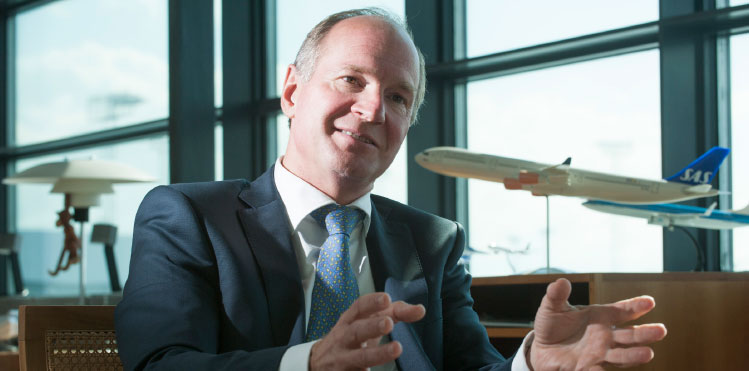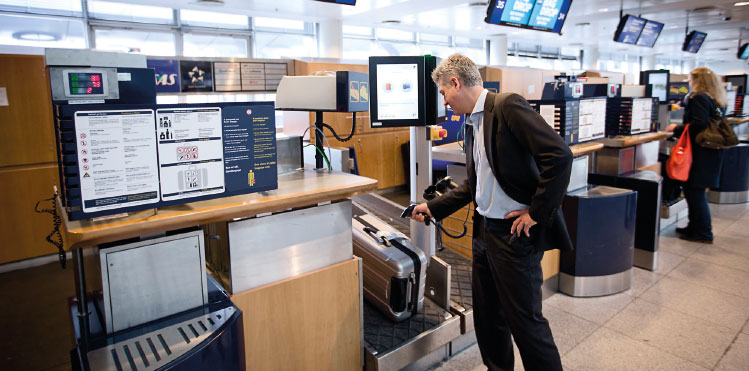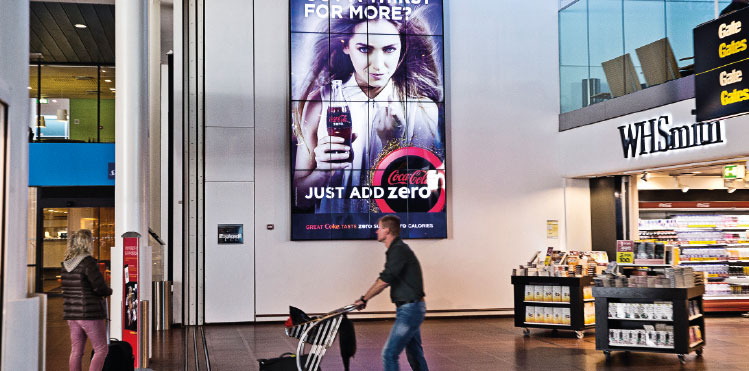
Thomas Woldbye, CEO Copenhagen Airports, told Airport Business that the objective of the current upgrades to Terminal 2 is to add space, light and ambience. “It will give us a better passenger flow,” he said.
When considering Europe’s most progressive airports, Copenhagen immediately springs to mind. The ‘Expanding CPH’ strategy involves phased expansion to ultimately accommodate 40 million annual passengers, and fresh ideas abound along this journey, as Thomas Woldbye, CEO Copenhagen Airports, explained to Ross Falconer.
When Airport Business first met with Copenhagen Airports CEO Thomas Woldbye in 2013, he articulated a bold vision for the airport predicated on developing a ‘World Class Hub’ strategy. This approach is built on an expansive focus on the end-to-end travel experience and, two years on from our initial CPH briefing, the vision has become reality in myriad ways.
The current ‘Expanding CPH’ strategy involves continuous expansion over the next decade to ultimately accommodate 40 million passengers per year. The latest developments are a DKK130 million (€18m) investment in the upgrade and expansion of Terminal 2 by 700sqm, and the addition of two new security lanes. “Terminal 2 is very well designed, but in need of an overhaul. A couple of years ago we added new check-in counters, and now the objective is to add space, light and ambience. It will give us a better passenger flow,” Woldbye commented. “The pattern we’ve chosen to follow is phased expansion, which offers several advantages. Our analysis has shown that, with this approach, we can avoid building excess capacity. Secondly, it allows us to keep the airport’s compact layout under one roof, which is important. Thirdly, a phased expansion allows us to adjust our process to match the increase in traffic and lets us make use of the latest technology.”
Another important development is the merger of domestic traffic into the same part of the airport as Schengen traffic. This means carriers operating domestic services and international services to countries in the Schengen zone – primarily SAS and Norwegian – can get their aircraft closer together, optimising operations. There are also plans to extend Pier C – the intercontinental pier – with three new gates and aircraft stands, and that project will be complete towards the end of 2015.
At this point, it’s worth noting the airport’s impressive traffic growth. CPH achieved record passenger numbers for the fourth consecutive year in 2014, with a 6.5% rise to 25.6 million. The latest available figures for February show a continuation of that growth trend, with throughput increasing by 1.2% to 1.7 million. Woldbye highlighted long-haul services as a major driver of growth, showing a 4% year-on-year increase. He sees “clear potential for more long-haul growth”, particularly through the business segment to Asia, and business and leisure traffic to the US.
Self-service a “win-win-win”

Copenhagen Airports CEO Thomas Woldbye explained that “passengers like self-service because it’s intuitive, faster and puts them in control”. 80% of eligible passengers use the airport’s automated bag drop, and more counters are being installed.
Woldbye speaks fluently about all aspects of the airport’s development, reserving most passion for the firm focus on the passenger experience. It is easy to view CPH as a benchmark of innovation among Europe’s airports. The prominent and increasing use of self-service technologies – new kiosks, self-boarding gates and automated bag drop counters are being installed – are just the tip of a strategy that empowers the passenger, and puts them in control of their own journey through the airport. The drive to meet that desire of travellers has produced tangible results. 80% of eligible passengers use the airport’s automated bag drop. “Passengers like self-service because it’s intuitive, faster and puts them in control. We’ve received very positive feedback and the take-up rate has been rapid. We are fortunate as Scandinavians tend to be very fast at adapting to smart solutions,” Woldbye enthused. “The other win is that it reduces costs for the airlines. An explicit part of our strategy is to reduce total cost of operations for our customers, and self-service does that. It also gives us more capacity within the same space as flows are increased. So passengers are happier, airlines are happier, and we get a little bit more capacity – a win-win-win situation.”
We are living in the age of the connected traveller, with digital technologies transforming the travel experience and the ways in which airports interact and communicate with passengers. CPH is embracing this in various ways. Last year it became the first airport to trial Google Glass, equipping two members of its airport service team with the devices, with positive results. It is also utilising augmented reality technology with an innovative 360-degree wayfinding function on the CPH smartphone App.
Enhancing e-commerce

CPH’s constant drive for innovation extends to the trialling of intelligent advertising, which incorporates facial recognition technology. It is early days, but another sign of the airport’s progressive approach.
Among the most exciting technologies being explored by CPH is the potential of beacons as a way of interacting with passengers. It is currently trialling these in the retail environment in connection with the CPH Advantage loyalty programme. The beacons can be used to trigger relevant messages to passengers who are nearby participating stores, informing them of promotions or offers. “Beacons are so far being used on an experimental basis; we haven’t drawn any conclusions yet,” Woldbye stated.
Commercial revenues are, of course, vitally important, and account for a 50% share of the total at CPH. While looking to make the retail offer even more attractive in the airport itself, Woldbye explained that there is a focus on enhancing e-commerce, “getting more people to order online and collect at the airport, or at least plan their purchases”. “We are also looking at whether we need more modern shop concepts – that I think is very much in line with more general retail trends, but with an airport twist,” he added.
The constant drive for innovation even extends to the trialling of intelligent advertising, which incorporates facial recognition technology. It is early days, but another sign of CPH’s progressive approach.
‘Expanding CPH’ is a clearly defined vision for the airport of the future in Copenhagen – a vision that paints a picture for CPH’s role as a hub for the region. Our conversation with Woldbye very clearly illustrated that this is being realised through a forward-thinking strategy that cements CPH’s status as a beacon of innovation among Europe’s airports.
CPH factbox
2014 passenger numbers: 25.6 million
2014 passenger traffic growth: +6.5%
2015 passenger traffic growth (Jan-Feb): +0.9%
Key airline customers: SAS, Norwegian, easyJet
Number of routes (2014): 151
Top 3 destinations: London, Stockholm, Oslo
Ratio of carriers: 73.5% full-service / 26.5% LCC







